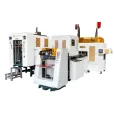Oct. 21, 2025
In today’s fast-paced packaging industry, the demand for premium and sustainable packaging continues to grow. Rigid boxes—commonly used for luxury goods, electronics, cosmetics, and jewelry—have become a symbol of quality and brand value. As manufacturers seek higher efficiency, precision, and customization, the intelligent fully automatic rigid box making machine has emerged as a game-changer. But what does the future hold for this advanced technology? Let’s explore the innovations shaping the next generation of rigid box production.
Traditional rigid box making machines automated basic tasks such as feeding, gluing, wrapping, and forming. However, the new generation of machines goes beyond automation—embracing artificial intelligence (AI), machine vision, and smart control systems.
Intelligent machines can now:
Automatically detect positioning errors and adjust in real time.
Analyze production data to optimize speed and minimize waste.
Identify glue inconsistencies or paper misalignment through vision sensors.
Predict maintenance needs before breakdowns occur.
This transformation marks a shift from “mechanical automation” to “intelligent manufacturing.”
The combination of AI (Artificial Intelligence) and IoT (Internet of Things) enables rigid box making machines to become fully connected smart systems.
Data-driven Production: Machines collect and analyze data from every cycle to improve accuracy and efficiency.
Remote Monitoring: Operators can monitor performance, temperature, and fault reports through cloud-based platforms.
Predictive Maintenance: Sensors and AI algorithms predict wear and tear, reducing downtime.
Adaptive Control: Machines automatically adjust parameters based on box size, paper type, or humidity levels.
These capabilities significantly improve productivity while reducing energy consumption and operational costs.

Modern vision-guided robotic arms are replacing manual positioning systems. High-speed cameras scan each piece of paper and board to ensure perfect alignment. The robot then places materials with sub-millimeter precision, eliminating human error.
This level of automation not only boosts accuracy but also allows for complex box designs, including magnetic closure boxes, drawer boxes, and collapsible gift boxes—all crafted with flawless precision.
As sustainability becomes a global priority, future rigid box making machines will focus on eco-conscious production:
Efficient Glue Systems: Reducing adhesive waste through controlled micro-glue application.
Energy Saving: Intelligent motors and servo systems optimize power usage.
Recyclable Materials: Machines are designed to handle biodegradable paper and eco-friendly coatings.
Additional resources:Low Emission Designs: Improved ventilation and temperature control minimize heat loss and emissions.
These innovations align luxury packaging with environmental responsibility—a key demand from global brands.
The future belongs to mass customization. Intelligent machines allow quick format changes, enabling manufacturers to produce different box sizes and shapes without long setup times.
Digital Control Interfaces: User-friendly touchscreens simplify parameter settings.
Automatic Size Adjustment: Servo-driven modules switch box dimensions in seconds.
3D Simulation: Operators can preview box designs digitally before production.
This flexibility supports small batch, multi-design production—a vital feature for e-commerce packaging and personalized branding.
Fully automatic rigid box making machines are becoming a crucial component of smart factories. By integrating with MES (Manufacturing Execution Systems) and ERP (Enterprise Resource Planning), they form a seamless production ecosystem.
Real-time Quality Monitoring through interconnected sensors.
Automatic Material Supply linked to warehouse systems.
Production Reports and Analytics generated automatically for management.
This level of integration ensures transparency, traceability, and maximum productivity across the entire packaging line.
Looking ahead, the future of the intelligent fully automatic rigid box making machine will focus on:
Higher AI Autonomy: Self-learning systems that continuously improve performance.
Collaborative Robotics: Safer, more flexible interaction between humans and machines.
Cloud-Based Control: Remote production management from any location.
Enhanced Sustainability: Zero-waste, low-carbon manufacturing solutions.
These advancements will redefine how packaging factories operate—delivering faster, smarter, and greener production.
The intelligent fully automatic rigid box making machine represents the next evolution in packaging technology. Combining AI, robotics, IoT, and sustainability, it enables manufacturers to achieve precision, flexibility, and eco-efficiency like never before. As consumer demand for luxury and environmentally friendly packaging grows, these machines will play a central role in shaping the future of the packaging industry.
If you are interested in sending in a Guest Blogger Submission,welcome to write for us!
All Comments ( 0 )